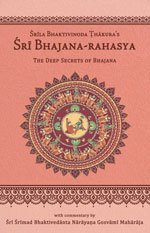Bhajana-Rahasya
by Srila Bhaktivinoda Thakura Mahasaya | 2010 | 123,965 words
The Bhajana-rahasya Text 5, English translation, including commentary (vritti). The Bhajana-rahasya is a compilation of verses describing the mercy of the eight pairs of names (Yugala-nama) of the Maha-mantra. This is text 5 belonging to the chapter “Shashtha-yama-sadhana (Sayam-kaliya-bhajana–bhava)” representing six dandas after dusk: approximately 6.00 p.m.–8.30 p.m.
Text 5
Bhakti-rasāmṛta-sindhu (2.3.16) describes the aṣṭa-sāttvika-bhāvas as follows:
ते स्तम्भ-स्वेद-रोमाञ्चाः स्वर-भेदो’थ वेपथुः
वैवर्ण्यम् अश्रु प्रलय इत्य् अष्टौ सात्त्विकाः स्मृताःte stambha-sveda-romāñcāḥ svara-bhedo’tha vepathuḥ
vaivarṇyam aśru pralaya ity aṣṭau sāttvikāḥ smṛtāḥThe aṣṭa-sāttvika transformations of bhāva are (1) becoming stunned (stambha ), (2) perspiration (sveda), (3) horripilation (romāñca), (4) faltering of the voice (svara-bheda), (5) trembling (kampa ), (6) loss of colour (vaivarṇya), (7) tears (aśru) and (8) loss of consciousness, or fainting (pralaya).
स्तम्भ, स्वेद, रोमाञ्च ओ कम्प स्वर-भेद
वैवर्ण्य, प्रलय, अश्रु विकार-प्रभेदstambha, sveda, romāñca o kampa svara-bheda
vaivarṇya, pralaya, aśru vikāra-prabheda
Commentary: Bhajana-rahasya-vṛtti:
In the pure consciousness (śuddhasattva) of the living entity, when the action of the heart (citta) becomes stimulated, it causes further action. At that time a natural wonderfulness arises, which makes the heart blossom in various ways. This externally manifests as udbhāsvaras, anubhāvas that manifest as external actions. These transformations, such as dancing, are of many varieties. When the anubhāvas, which nourish vibhāva, arise in the heart, they pervade the body as udbhāsvaras.
The word sattva refers to the heart that is directly stimulated by transcendental sentiments. The bhāvas, or emotions, that arise from this sattva are called sāttvika-bhāvas. Becoming stunned (stambha), trembling (kampa) and so forth are symptoms of sāttvika transformations. When the sādhaka’s heart attains oneness with sāttvika-bhāvas, it submits itself to the life air (prāṇa). Then, when the prāṇa is excited, it is transformed, causing excessive agitation to the body. At that time, stambha (becoming stunned) and other transformations arise.
In anubhāvas such as dancing (nṛtya ), the bhāva that is manifested by sattva does not directly perform the activity. Rather, the activity is performed as a result of the intelligence being stimulated. In the sāttvika-bhāvas such as stambha, however, the intelligence is not needed, as the sāttvika-bhāva itself directly performs the activity. For this reason, anubhāvas and sāttvika-bhāvas are considered to be different.
In some conditions, the life air (prāṇa ) becomes present as the fifth element, together with the other four elements of earth, water, fire and sky. Sometimes it consists mainly of itself–that is, it is predominated by air (vāyu)–and it moves throughout the body of the living entity. When the prāṇa comes in contact with the earth element, inertness (stambha) is observed; when it takes shelter of water, tears (aśru) manifest; when it contacts fire, perspiration (sveda) and change in bodily colour (vaivarṇya ) are evident; and when it takes shelter of sky, it manifests devastation (pralaya ) or loss of consciousness (mūrccha). When it consists predominately of itself, or in other words, when it takes shelter of the element air, horripilation (romāñca), trembling (vepathu ) and faltering of the voice (svara-bheda) manifest respectively, corresponding to the degree of the life air’s strength, whether it be mild, moderate or intense.
Stambha is a state in which one becomes inert, and it arises from jubilation, fear, astonishment, dejection, regret, anger and depression. Perspiration (sveda) arises from jubilation, fear, anger, etc. When the bodily hairs stand on end, the condition is known as romāñca, and it arises from astonishment, jubilation, enthusiasm and fear. Faltering of the voice (svara-bheda) arises from despair, wonder, anger, jubilation and fear. Trembling (vepathu) is caused by fear, anger, jubilation, etc. When the body changes colour it is called vaivarṇya, and it arises from despair, anger, fear, etc. Tears (aśru) come from the eyes through the influence of jubilation, anger, despair, etc. Tears of joy are cool, whereas tears of anger and so forth are warm. Cessation of all action, loss of consciousness, becoming motionless and falling to the ground are called pralaya. Pralaya arises from both happiness and distress.
These sāttvika-bhāvas manifest in five stages of intensity, according to the progressive gradation of sattva: (1) smouldering (dhūmāyita), (2) f laming (jvalita ), (3) burning (dīpta), (4) brightly burning (uddīpta ) and (5) blazing (sūddīpta). They are gradually reflected in the heart of a sincere, pure devotee according to the level of his sādhana. Many people exhibit these bhāvas to impress others or to achieve success in their own activities in this material world, but such demonstrations are not the transcendental sentiments of pure devotion.
